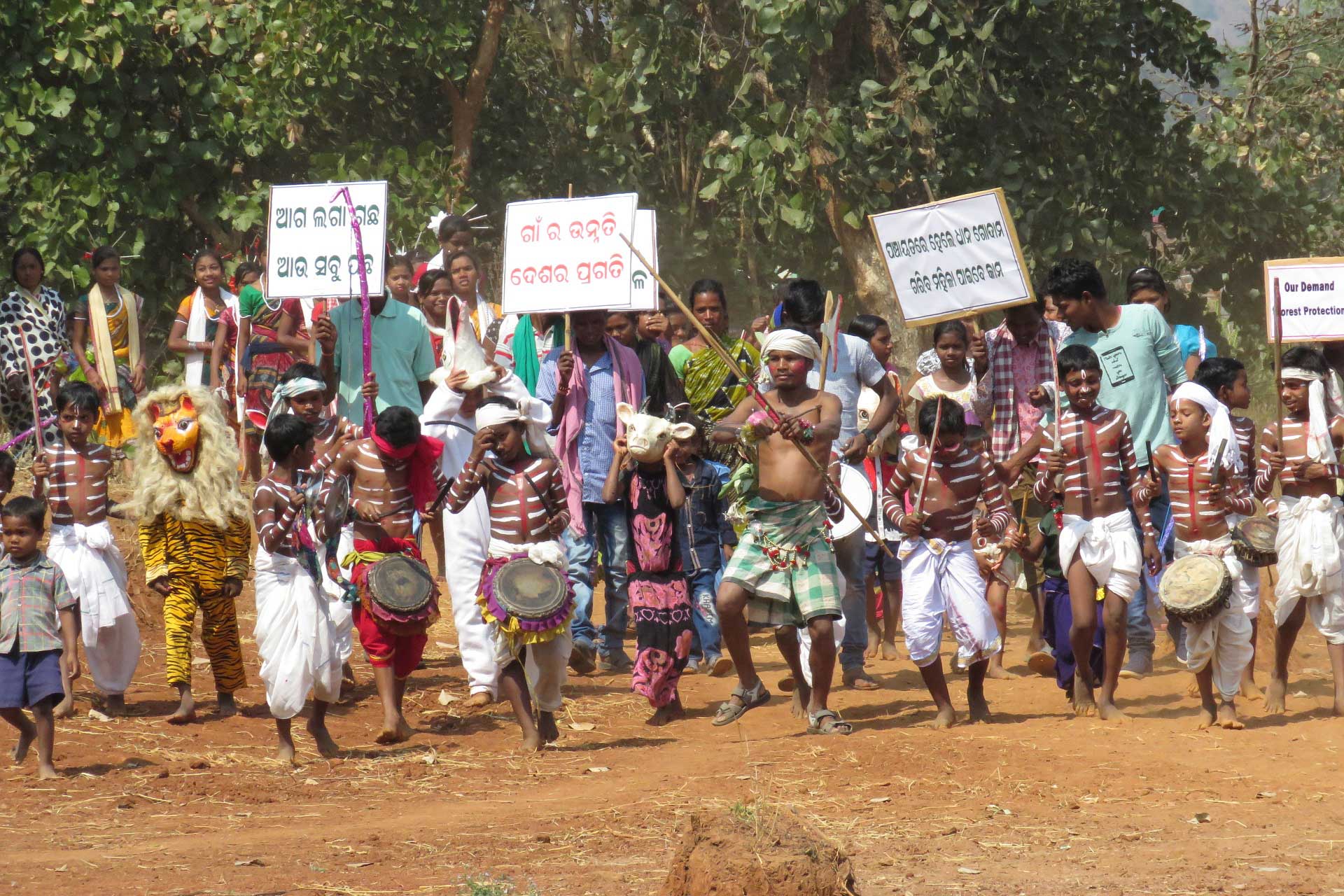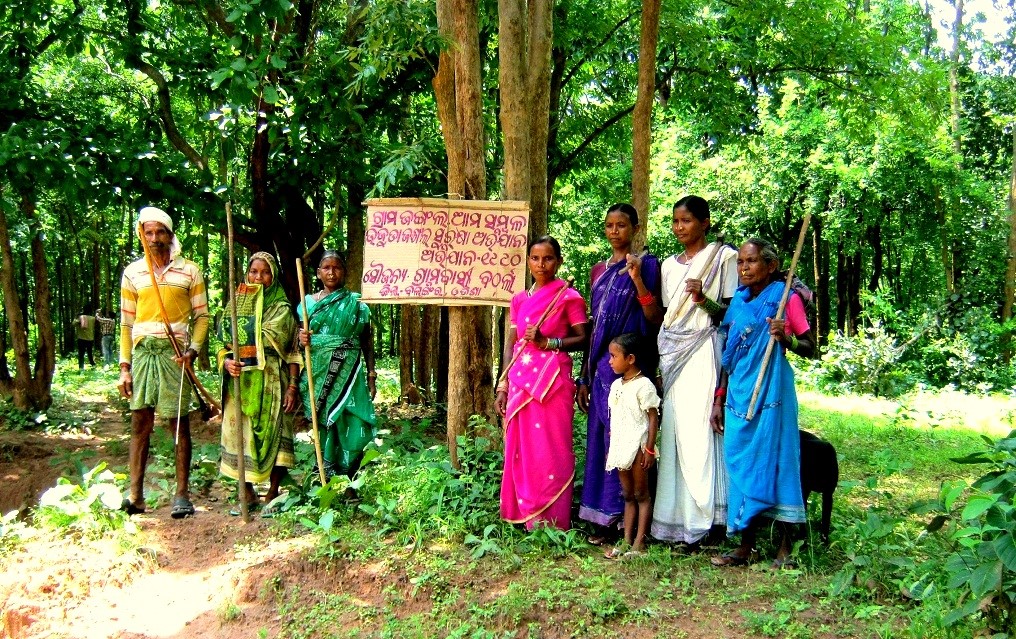
AGGA Model

In the 1970s, the economic damage in the state of Odisha was estimated to be INR 10.5 billion from natural disasters which increased by seven times by the 1980s and nearly ten times in 1990s (HDR, 2004). Towards the end of 1980s, migration of rural/tribal communities was at its peak especially after the Nuakhai festival (a local annual harvest festival) owing to the impact of famine and subsequent droughts. The situation continued to be at a standstill despite the measures undertaken by the government.
During this time, hunger and starvation related deaths became a common phenomenon while children were exposed to the risk of being sold and trafficked. ‘Goti Pratha/Bonded Labour’ became prevalent due to such severe conditions where many families were forced into bonded labour due to the surmounting pressure of poverty, hunger and starvation. The lack of social and economic security led to exploitation from the rich and powerful moneylenders who made such families work at significantly lower wages and lured them to spend further on alcohol shops owned by them. This started a never-ending cycle of poverty and exploitation for many deprived tribal families in the region.
What is the AGGA Model?
Adarsh Gram Gathan Abhiyan (AGGA) model was initiated by AJSA under its Gram Swaraj Abhiyan Initiative in the early 1990s in Western Odisha seeking to address the state of economic, social distress and the vicious cycle of poverty created by natural disasters and migration in the region. Owned and initiated by the people themselves, the model incorporates a set of ideologies that were incremental in bringing change through a human rights perspective which would help in the development of self-reliant villages.
- Liquor Free Village
- Loan Free Village
- Police Station Free Village
- Fertilizer Free Village
- Creation of Community Forestry
- Formation and strengthening of SHGs
During the 90s drought was quite prevalent in western Odisha, People living in deprived communities, and people with lower socio-economic status were more exposed and more vulnerable to tangible problems and negative consequences of alcohol consumption. Money lenders and local landlords/mafias were exploiting poor peasants by alluring alcohol which was leading them to perpetual hunger and drudgery.
With the support of local women, various local alcohol outlets/thekas were set on fire. It occurred amidst rising tension and protest from locals as well as subsequent arrest made by the law enforcements. However, AJSA and the women involved in the act were successful in garnering the support of district authorities which helped in bringing down many such local outlets/thekas thereby reducing the economic pressure created at household levels due to the expenditure on alcohol.


Creation of Loan Free Village through formation Grain Banks to reduce dependence on moneylenders – Loan Free Village
During the time, due to increasing hunger and starvation, many people from marginalised families migrated to other areas in search of livelihood. This often left them dependent on moneylenders who provided them loans at very high rates of interest (which could go up to 50-80%). In addition, such families were also forced to leave their valuables with the moneylenders.
To address this food insecurity and exploitation by moneylenders, AJSA started Grain Banks in various villages. The model promotes citizen participation and self-reliance through creation of banks of food grain where each household would contribute at least 25 kilograms of paddy after harvesting. The Grain Banks provided an opportunity for deprived families to secure food grains without the exploitation they faced from moneylenders. In this model, the families could return the food grain borrowed from the bank when they are capable at minimal interest rates of 20-25% (in the form of food grains itself). The success of the Grain Bank Model helped in storing 1290 quintals of paddy across 46 Grain Banks in 46 villages.
https://www.iatp.org/news/seed-banks-to-the-rescue
https://reliefweb.int/report/india/prayas-innovations-and-learnings-csos-drr-volume-1



Western Odisha has been experiencing one of the severest drought conditions in the last 100 years. It has severely paralyzed the already poor people of western Odisha especially in Bolangir district – the second most backward district of the Country. The district is one of the most drought-prone regions of India. The landless agriculture workers and marginal farmers are the worst affected in a drought situation. The latter resort to distress mortgaging or selling of their little, yet precious land (also other household articles) to none other than big farmers who are also the labour contractors, and migrate along with their families to far off places in search of wage employment. Thus, drought causes economic, social, psychological and political misery to the poor. Agriculture continues to remain the primary source of livelihood in the district. But since agriculture is dependent on the vagaries of rainfall and irrigation facilities are inadequate, it leads to crop loss resulting in large scale unemployment and distress migration.
Nevertheless, communities in Bolangir have also demonstrated that a system of sharing benefits of the harvest with the village community is a viable alternative to meet growing threat of food insecurity fuelled by natural calamities like drought.
Starvation and hunger no longer stalk the cluster of 20 villages, about 150 km away from Bolangir town. At a time when recurring drought has brought acute misery and suffering for many in the district, families in and around,the Sundhimunda village have built a food insurance system that keeps sure hunger and death at bay. That the food security system has successfully withstood varying degrees of natural calamities and has, in fact, grown and multiplied clearly demonstrates its social relevance and effectiveness. The traditional food security system is popularly known as grain banks from where – a person/villager in need can take grain loans at the time of need and can return in easy installments. The main objective behind setting grain banks is establishing a system where food is available to poorest families in distress.
Before creation of the grain and seed banks or the Sashya panthi, people lived in dire poverty and semi starvation situation. And they were pauperized by money lenders. They were bound to take loan in the form of paddy or money from money lenders by mortgaging land pattas, ornaments and other assets at 100% interest rate. They had to return double the amount of either money or paddy due to high interest rate. Many times, people ended up losing their security.
It all began in 1990-91 when a CBO namely AJSA (Anchalika Jana Seva Anusthan) was looking for a permanent solution to mitigate the problems arising out of non-availability of food grains, especially at times of distress. They appealed to fellow villagers to donate surplus paddy and rice after the harvest to build a grain reserve of 22 quintals of paddy. A total of 150 families – mostly marginal farmers – from eight villages responded to the call and the village grain bank was formed under the leadership of SHG members and AJSA.
Anusthan) was looking for a permanent solution to mitigate the problems arising out of non-availability of food grains, especially at times of distress. They appealed to fellow villagers to donate surplus paddy and rice after the harvest to build a grain reserve of 22 quintals of paddy. A total of 150 families – mostly marginal farmers – from eight villages responded to the call and the village grain bank was formed under the leadership of SHG members and AJSA.
 The grain bank became a pivot of food security. Farmers have since then deposited their surplus produce with the bank after each paddy harvest. They withdraw an equal quantity of paddy at the time of need without having to pay interest. Others who were landless or did not have any surplus for the grain bank borrowed paddy at the time of distress. But at the time of harvest, the grains borrowed had to be returned with half a bucket of paddy as interest. For those who could not repay the food grain loan, the Village Development Committee (VDC) which record the details decided whether the loan can be waived or not.
The grain bank became a pivot of food security. Farmers have since then deposited their surplus produce with the bank after each paddy harvest. They withdraw an equal quantity of paddy at the time of need without having to pay interest. Others who were landless or did not have any surplus for the grain bank borrowed paddy at the time of distress. But at the time of harvest, the grains borrowed had to be returned with half a bucket of paddy as interest. For those who could not repay the food grain loan, the Village Development Committee (VDC) which record the details decided whether the loan can be waived or not.
For the villagers, the grain bank was a relief from the clutches of money-lenders. The stock in the grain banks provided food security for a period of two to four months in years of crop failure. During drought period, villagers took loan from their own grain banks at 25% interest rate and returned after harvesting.
Sometimes, depending upon the immediate requirement of the participating villages, the beneficiaries were asked to contribute by way of human labour. In village Batharla, a community temple and a grain store house was constructed by the beneficiaries. Their wages were paid in kind from the interest (surplus grain) that had built up over the years. A traditional water harvesting tank was rejuvenated in Banjupadhar village for which the community distributed 16 quintals of paddy as wages. The grain bank was utilised for ‘Food for Work’ programmes depending upon the need of the village community. Along with grains, people also stored indigenous seeds.
In five years, the grain bank grew in size and volume. In 1996, the society received and disbursed 220 quintals of paddy. A year later, in 1997, it got back 253 quintals. In all, the number of people donating to the grain bank had grown by almost ten times, with a thousand families depositing paddy. The number of beneficiaries too increased over the years reaching 1,066 families in two years, in the 20 participating villages. These families had perfected a social model that gave them freedom from hunger. Due to the grain banks, the consequent food insecurity and starvation death was minimized in the area. It played the role of draught proofing fund which greatly supported small and marginal farmers in their cultivation. As of 2014 844 quintals of grain has been stored in the grain banks.
In 1996, the society received and disbursed 220 quintals of paddy. A year later, in 1997, it got back 253 quintals. In all, the number of people donating to the grain bank had grown by almost ten times, with a thousand families depositing paddy. The number of beneficiaries too increased over the years reaching 1,066 families in two years, in the 20 participating villages. These families had perfected a social model that gave them freedom from hunger. Due to the grain banks, the consequent food insecurity and starvation death was minimized in the area. It played the role of draught proofing fund which greatly supported small and marginal farmers in their cultivation. As of 2014 844 quintals of grain has been stored in the grain banks.
The effort of AJSA and community leaders was cited in “Planning Commission’s Reports and Human Development” Reports of Govt. of India.
Creation of Community Forestry – AJSA has also been promoting social forestry because it supports sustainable livelihood and recognizes the rights of individuals to forest resources. It motivated communities to collectively manage their social forestry plantations. These activities raised the income of the community. The community-management and sharing of benefits developed community unity. As of 2015 ,about 42 village level Forest Protection Committees (FPCs) covering and protecting around 5020 hectares of forest in Bongomunda block of Bolangir district. Each family contributes some amount of food grain every month to meet the expense of protection work. These strategies not only raise community income, but also increase the sense of community ownership of resources through cooperative management of land. Villagers guard the nearby patches with lathis to ensure that the ecosystem is protected. Now women are taking active part in forest protection, by making groups in villages like batharla, Barkani, Kurlubhata.

Women Leaders are leading role in forest protection activities

A Forest Protection Committee member sharing their success story
Despite its huge impact, lack of storage facility for the grains is still an issue for hundreds of villagers who are bound to sell their surplus grain every year. Besides, the grain bank houses are not safe from rain water, rats, insects because houses are made of of mud and soil. So, some grains and seeds get wasted and become unsafe due to excessive rains.
It is critical to tackle the causes of poverty, hunger, inequitable distribution of income and low human resource base to build community resilience for disasters, especially drought. Food security and hunger are directly linked to the community’s control over natural resources and also on long-term sustainability of the resource base.
Under the Gram Swaraj Abhiyan, AJSA supported the strengthening of Panchayats. Following a participatory approach, the organization focused on creating of conducive environments where local issues are solved in the Panchayats itself. The aim was to reduce the instances of police brutality. Panchayats were facilitated to organize meetings with its citizens whenever there were local issues arising from the villages itself. Women were especially encouraged to participate in the meetings where Panchayats ensured equality and equity among its citizens.

Since its inception, AJSA has been promoting the idea of organic farming &holistic production management system that promotes and enhances agro-ecosystem health, including biodiversity, biological cycles, and soil biological activity. Under the AGGA initiative, AJSA adopted the concept of the creation of “Fertilizer Free Villages” to bring promising prospects both in terms of welfare and nature improvement as well as food diversity.
Through various innovative approaches to organic farming and sustainable agriculture practices, we have created 44 fertilizer-free model villages in Odisha. We encourage small and marginal farmers/agriculture producers to opt for organic agriculture through various innovative agricultural practices to enhance their agricultural production i.e Crop Rotation, Cover Cropping, Green Manures, Animal Manures, Integrated Weed Management and Integrated Pest Management.

AJSA Action on Sustainable Forest Management.
From the beginning AJSA promotes Social Forestry because it supports sustainable livelihoods and recognizes the rights of individuals to forest resources. AJSA motivates communities to collectively manage their social forestry plantations: These activities raise the income of the community and the community-management andsharing of the benefits develop community unity. Today there are about 42 villages level FPCs covering and protecting around 5020 hectares of forests in Bongomunda block of Bolangir District in Odisha, now these forests are now totally in community control. Each family used to contribute some amount of food grain every month to meet the expenses of the protection work. These strategies not only raise community income, but also increase the sense of community ownership of resources through the cooperative management of land. This has now become the one of the best success stories regarding safeguarding a forest through community participation. Villagers guard the nearby patches with ‘lathis’ to ensure that the ecosystem is protected. As a result of the vigil, tigers, which had once disappeared from the area, have reappeared in the Barkani village as reported this year by some of the villagers.Now women’s are taking active part in forest protection, by making groups in villages like batharla, Barkani, Kurlubhata.


Meet the Guardians of the Forest

Since its inception, AJSA has been persistently engaged with women’s groups and committees at the Village, Panchayat and Block level. Women, especially in villages, experienced the denial of their basic rights and the failure of society and systems to treat them with equality and equity. By organising them into collectives (in the form of Self-Help Groups or Mahila Mandals), women were able to access a sense of security required to gain a stronger voice and to participate in the decision-making processes of their villages.
Through a multi-pronged process of organisation building, training and skill development, AJSA primarily kept rural and Dalit women at the centre. With the strength of 152 Self-Help Groups, more than 16,000 hectares of forest land and its non-timber produce were conserved and revived.
Apart from these AGGA approaches also strives to create a holistic development of villages by bringing visible positive change in Livelihood, education, health, gender equality, Water & sanitation, Governance and Climate change and DRR aspects.

AJSA supports catalytic community-based organizations that are working with their own communities to build smart, sustainable, and potentially scalable solutions to the challenges faced by pro-poor communities.
 En
En
 Fr
Fr
 Ge
Ge
 It
It





















